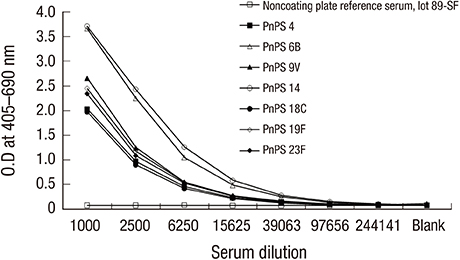1. Brooks GF, Carroll KC, Butel JS, Morse SA. The streptococci. In : Brooks GF, Butel JS, Morse SA, editors. Jawetz, Melnick, & Adelberg's Medical Microbiology. 23rd ed. New York, NY: McGraw-Hill;2004. p. 231–247.
2. Zenni MK, Cheatham SH, Thompson JM, Reed GW, Batson AB, Palmer PS, Holland KL, Edwards KM. Streptococcus pneumoniae colonization in the young child: association with otitis media and resistance to penicillin. J Pediatr. 1995; 127:533–537.
3. Leinonen M, Säkkinen A, Kalliokoski R, Luotonen J, Timonen M, Mäkelä PH. Antibody response to 14-valent pneumococcal capsular polysaccharide vaccine in pre-school age children. Pediatr Infect Dis. 1986; 5:39–44.
4. Mufson MA, Hughey D, Lydick E. Type-specific antibody responses of volunteers immunized with 23-valent pneumococcal polysaccharide vaccine. J Infect Dis. 1985; 151:749–750.
5. Shinefield HR, Black S. Efficacy of pneumococcal conjugate vaccines in large scale field trials. Pediatr Infect Dis J. 2000; 19:394–397.
6. Oosterhuis-Kafeja F, Beutels P, Van Damme P. Immunogenicity, efficacy, safety and effectiveness of pneumococcal conjugate vaccines (1998–2006). Vaccine. 2007; 25:2194–2212.
7. Quataert SA, Kirch CS, Wiedl LJ, Phipps DC, Strohmeyer S, Cimino CO, Skuse J, Madore DV. Assignment of weight-based antibody units to a human antipneumococcal standard reference serum, lot 89-S. Clin Diagn Lab Immunol. 1995; 2:590–597.
8. Wernette CM, Frasch CE, Madore D, Carlone G, Goldblatt D, Plikaytis B, Benjamin W, Quataert SA, Hildreth S, Sikkema DJ, et al. Enzyme-linked immunosorbent assay for quantitation of human antibodies to pneumococcal polysaccharides. Clin Diagn Lab Immunol. 2003; 10:514–519.
9. Concepcion NF, Frasch CE. Pneumococcal type 22F polysaccharide absorption improves the specificity of a pneumococcal-polysaccharide enzyme-linked immunosorbent assay. Clin Diagn Lab Immunol. 2001; 8:266–272.
10. Coughlin RT, White AC, Anderson CA, Carlone GM, Klein DL, Treanor J. Characterization of pneumococcal specific antibodies in healthy unvaccinated adults. Vaccine. 1998; 16:1761–1767.
11. Center for Drug Evaluation and Research (US). Center for Veterinary Medicine (US). Guidance for Industry: Bioanalytical Method Validation. Silver Spring, MD: Food and Drug Administration;2001.
12. Frasch CE, Plikaytis B, Carlone G, Goldblatt D. Pneumococcal ELISA standardization: Calibration sera [Internet]. accessed on 24 May 2017. Available at
https://www.vaccine.uab.edu/.
13. Plikaytis BD, Goldblatt D, Frasch CE, Blondeau C, Bybel MJ, Giebink GS, Jonsdottir I, Käyhty H, Konradsen HB, Madore DV, et al. An analytical model applied to a multicenter pneumococcal enzyme-linked immunosorbent assay study. J Clin Microbiol. 2000; 38:2043–2050.
14. Lee HJ, Park SE, Kim KH. Immune response to 19A serotype after immunization of 19F containing pneumococcal conjugate vaccine in Korean children aged 12–23 months. Korean J Pediatr. 2011; 54:163–168.
15. Lee H, Nahm MH, Kim KH. The effect of age on the response to the pneumococcal polysaccharide vaccine. BMC Infect Dis. 2010; 10:60.
16. Ambrosino DM. Impaired polysaccharide responses in immunodeficient patients: relevance to bone marrow transplant patients. Bone Marrow Transplant. 1991; 7:Suppl 3. 48–51.
17. Paris K, Sorensen RU. Assessment and clinical interpretation of polysaccharide antibody responses. Ann Allergy Asthma Immunol. 2007; 99:462–464.
18. van Montfrans JM, Hoepelman AI, Otto S, van Gijn M, van de Corput L, de Weger RA, Monaco-Shawver L, Banerjee PP, Sanders EA, Jol-van der Zijde CM, et al. CD27 deficiency is associated with combined immunodeficiency and persistent symptomatic EBV viremia. J Allergy Clin Immunol. 2012; 129:787–793.e6.
19. Goldblatt D, Plikaytis BD, Akkoyunlu M, Antonello J, Ashton L, Blake M, Burton R, Care R, Durant N, Feavers I, et al. Establishment of a new human pneumococcal standard reference serum, 007sp. Clin Vaccine Immunol. 2011; 18:1728–1736.
20. Belmonti S, Lombardi F, Morandi M, Fabbiani M, Tordini G, Cauda R, De Luca A, Di Giambenedetto S, Montagnani F. Evaluation and optimization of an ELISA procedure to quantify antibodies against pneumococcal polysaccharides included in the 13-valent conjugate vaccine. J Immunoassay Immunochem. 2016; 37:189–200.









 PDF
PDF ePub
ePub Citation
Citation Print
Print






 XML Download
XML Download